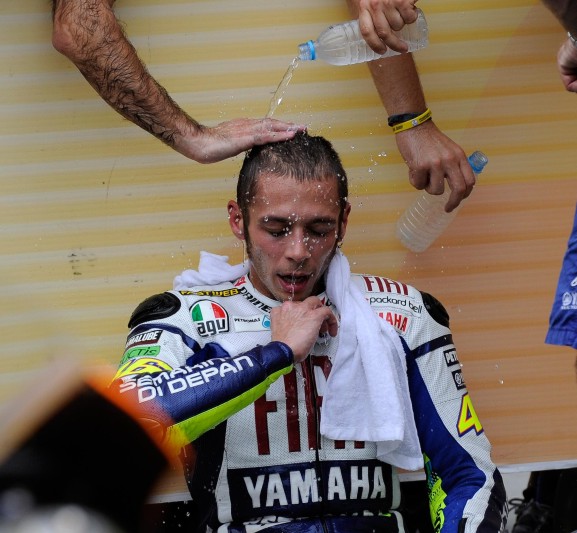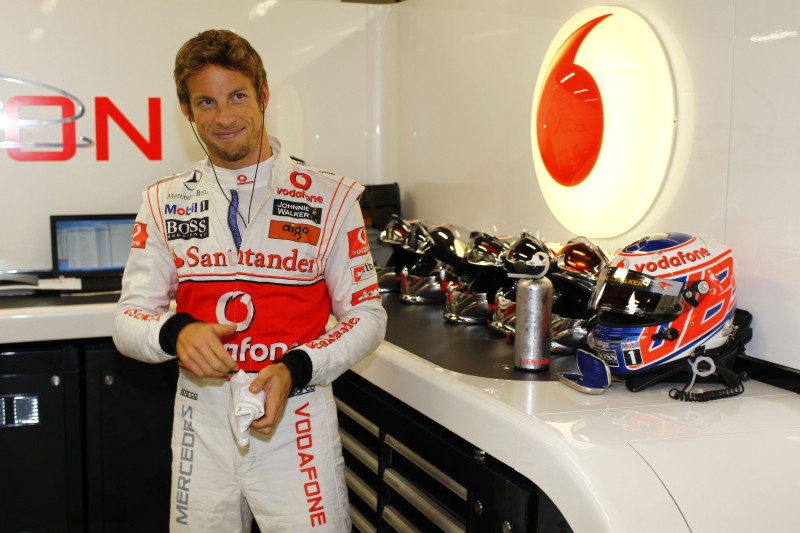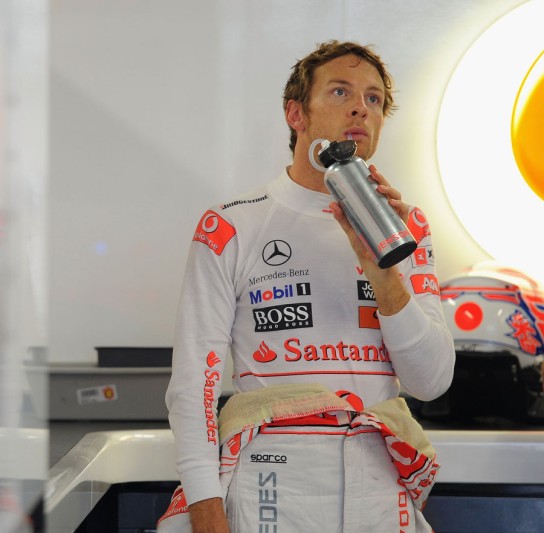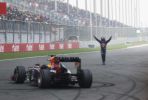F1 2011
Are you fit enough to be a world-class racing driver? Part 2
What is the first thing you do when you start to sweat? You tend instinctively to drink water like a camel, believing that this will be the best solution to replenish the lost amount of fluid.
Unfortunately, this is a very dangerous behaviour no matter how young and fit you think you are.
Drinking too much water can lead to a condition known as water intoxication and related problems resulting from the dilution of sodium in the body, namely hyponatremia. Water intoxication is most commonly seen in infants under the age of six months and in athletes. Even a baby can get water intoxication as a result of drinking several bottles of water a day or from drinking infant formula that has been too diluted. Athletes can also suffer from water intoxication, as they sweat heavily, losing both water and vital electrolytes.
Low levels of dehydration can have substantial physiological consequences. A loss of 2% bodyweight (just 1kg for a 50kg person) causes an increase in perceived effort and is claimed to reduce performance by 10-20%.
A fluid loss exceeding 3-5% bodyweight reduces aerobic exercise performance noticeably and impairs reaction time and reflex, judgment, concentration and decision making - vital elements in all sports, from pole-vaulting to football, and even more crucial in motorsport.
All the above-mentioned attributes can finely distinguish between a podium finish and D
The early warning signs are often subtle and may be similar to dehydration and include nausea, muscle cramps, disorientation, slurred speech, and confusion. At this point, many athletes drink more water because they think they are dehydrated.
Unfortunately, water alone will intensify the problem of hyponatremia, thus reinforcing the vicious circle. At the most extreme an athlete may experience seizures, coma, or even death.
What makes the electrolyte sodium a critical element, is the wide scope of vital functions it is involved in. Adequate sodium balance is necessary for transmitting nerve impulses and proper muscle function, and even a slight diminution of this concentration can cause problems.
Studies have shown that high intensity athletes can lose up to 2 grams of salt per liter of sweat. For a Formula 1 driver, who may be losing up to 3 liters during a race, this can mean a loss of approximately 6 grams of salt.
Hyponatremia is generally the result of drinking extreme amounts of plain water which leads to diminished concentration of sodium in the blood. Once a rare occurrence at sporting events, now it is becoming more prevalent as the participation of novice exercisers are entering endurance events without being aware of the drawbacks of this dangerous act!
This can be visualized by the following example: Imagine having 2 glasses of water and both contain the same concentration of ink. Then take one glass of them and discard 50% of it and refill it with plain water. Do the same to the 2nd cup of water and refill it with an ink/water solution resembling the starting one.
The result is very obvious: the first cup will be brighter whereas the second one will retain its original color. This is what occurs in the bloodstream of an athlete who rehydrates only with pure water during excessive sweating. The result is hyponatremia.
The best way to evaluate the amount of sweat lost is to calculate it through sweat analysis, which is a non-invasive procedure, where a sweat sample is collected using a special sweat stimulation procedure. A tiny amount of a sweat-stimulating liquid is applied to a small patch of skin on the arm or leg. An electrode is then placed over the site and a weak electrical current stimulates the area.
This is a painless procedure that may create a tingling or warm sensation. After several minutes, the area is cleaned and sweat is collected for about thirty minutes, either into a plastic coil of tubing or onto a piece of gauze or filter paper.
The sweat obtained is then analyzed.
After the sweat analysis is done, the results can be used to give feedback to the athlete to improve their hydration practices. Some people may be found to be 'salty sweaters', meaning they have high concentration of sodium in their sweat. These individuals may benefit from appropriate modification to their fluid and food intake for optimal electrolyte replacement. Research can also be performed to determine if sodium losses change throughout an endurance event, under different conditions and exercise intensities.
In the Middle East, following a tailored liquid intake program is even more important, due to the challenging temperatures and humidity levels racing drivers face in this geographical area.
Therefore, for drivers who live and perform professional motorsport in the Middle East, following these guidelines are even more important than their counterparts who race in more human-friendly environments.
For example, bikers who participate at the Qatar Moto GP or Abu Dhabi desert challenge or who are planning to get prepared for the Abu Dhabi Moto GP in 2012, following a personalized liquid/electrolyte intake regimen is of utmost importance, as being exposed to direct sunrays makes them even more susceptible to significant dehydration and consequently diminishing their performance.
If however hyponatremia should happen for any reason, an athlete should drink sodium containing sports drink/electrolyte mixture, or eat salty foods.
Ideally planning ahead and estimating the expected fluid loss and need for sodium replacement during the event, and staying on a strict electrolyte hydration schedule during the race will prevent this from happening and may be a reason for you to make it to the podium in an international world-class event and even win it.
Alhussein El-Shennawy
Related articles:
#SaferCarsForEgypt
 Want to sell your used car or buy one? Then check out our new used car market section
here!
Want to sell your used car or buy one? Then check out our new used car market section
here!
 Looking for a good service center or aftersales customer service? Did you have any bad experience with your car dealer or service center? Then check our 'automotive evaluation charts'
here!
Looking for a good service center or aftersales customer service? Did you have any bad experience with your car dealer or service center? Then check our 'automotive evaluation charts'
here!
Is Egyptian car market corrupt or collapsing?

Is the Egyptian car market collapsing or is it just a corrupt and unprofessional car market?
This is surely one of the most asked questions these days. Everybody is asking ...
AutoArabia Consulting
Middle East Car of the Year

Read more
Crash Test Results

Subscribe







 Daniel Ricciardo joins Renault Sport Formula One Team ...
Daniel Ricciardo joins Renault Sport Formula One Team ... Renault reinvents the Espace at the 2014 Paris Motor Show
Renault reinvents the Espace at the 2014 Paris Motor Show SEBASTIAN VETTEL WINS ABU DHABI F1 GP WITH TWO PIT STOPS
SEBASTIAN VETTEL WINS ABU DHABI F1 GP WITH TWO PIT STOPS INFINITI RED BULL RACING AND RENAULTSPORT F1: QUADRUPLE ...
INFINITI RED BULL RACING AND RENAULTSPORT F1: QUADRUPLE ... SEBASTIAN VETTEL AND INFINITI RED BULL RACING SEAL ...
SEBASTIAN VETTEL AND INFINITI RED BULL RACING SEAL ... Clever strategy brings Sebastian Vettel and Red Bull ...
Clever strategy brings Sebastian Vettel and Red Bull ... Dominant Sebastian Vettel and Red Bull cruse to victory ...
Dominant Sebastian Vettel and Red Bull cruse to victory ... RENAULT-POWERED DRIVERS LOCK OUT GERMAN GRAND PRIX PODIUM
RENAULT-POWERED DRIVERS LOCK OUT GERMAN GRAND PRIX PODIUM Sebastian Vettel scores with Red Bull his first German ...
Sebastian Vettel scores with Red Bull his first German ... Sebastian Vettel and Red Bull coast to runaway victory ...
Sebastian Vettel and Red Bull coast to runaway victory ...




